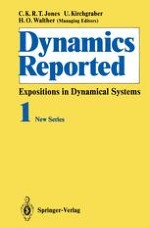1992 | OriginalPaper | Buchkapitel
Center Manifold Theory in Infinite Dimensions
verfasst von : A. Vanderbauwhede, G. Iooss
Erschienen in: Dynamics Reported
Verlag: Springer Berlin Heidelberg
Enthalten in: Professional Book Archive
Aktivieren Sie unsere intelligente Suche, um passende Fachinhalte oder Patente zu finden.
Wählen Sie Textabschnitte aus um mit Künstlicher Intelligenz passenden Patente zu finden. powered by
Markieren Sie Textabschnitte, um KI-gestützt weitere passende Inhalte zu finden. powered by
Center manifold theory forms one of the cornerstones of the theory of dynamical systems. This is already true for finite-dimensional systems, but it holds a fortiori in the infinite-dimensional case. In its simplest form center manifold theory reduces the study of a system near a (non-hyperbolic) equilibrium point to that of an ordinary differential equation on a low-dimensional invariant center manifold. For finite-dimensional systems this means a (sometimes considerable) reduction of the dimension, leading to simpler calculations and a better geometric insight. When the starting point is an infinite-dimensional problem, such as a partial, a functional or an integro differential equation, then the reduction forms also a qualitative simplification. Indeed, most infinite-dimensional systems lack some of the nice properties which we use almost automatically in the case of finite-dimensional flows. For example, the initial value problem may not be well posed, or backward solutions may not exist; and one has to worry about the domains of operators or the regularity of solutions. Therefore the reduction to a finite-dimensional center manifold, when it is possible, forms a most welcome tool, since it allows us to recover the familiar and easy setting of an ordinary differential equation.
